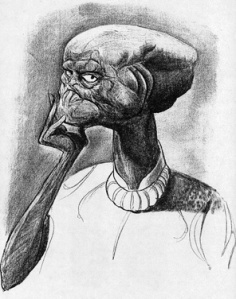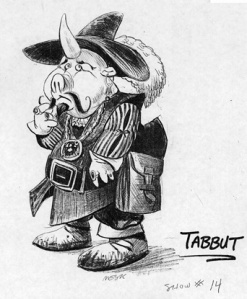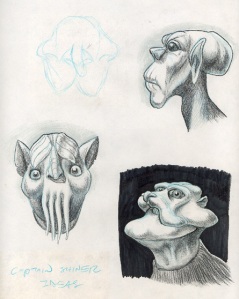If you happen to know the next couple of utterances that follow that repetitive call, then you may not know it, but I had a big effect on your childhood.
It’s generally not well known that in the 1980’s, when I lived in New York, I had a job at Rankin/Bass productions. (Yes, the same Rankin/Bass of “Rudolph the Red-Nosed Reindeer” fame; his cute little articulated figure was in a special case at the office.)
I was the chief character designer of their hit animated show, Thundercats.
I was not only the chief character designer, I was the ONLY illustrator on the premises.
The main heroes, Lion-O, Snarf, Tygra, Cheetara, Panthro and the main antagonists, the “Mutants”, and the villainous Mumm Ra were all designed by another artist before I got my job. My job became designing all the new characters that populated “Third Earth”, and a lot of weapons, devices, vehicles, and strange plants and animals.
Originally, I had been hired to do storyboards, based on my experience, much inflated by me, of working at Hanna Barbera studios in Hollywood, which I did in 1978. I was totally undeserving of the job of storyboard artist, as I was entirely untrained, really had mostly just darkened with #2 pencils the blue-pencilled storyboards of my senior, Don Rico.
I knew about as much about telling a story visually with a storyboard as I did about whaling.
Perhaps that became apparent in my first weeks at Rankin/Bass. In any case, for some reason that was intensely satisfying to me, I was taken off storyboards, and told to design CHARACTERS, starting with a character named “Pumm Ra”, a half man, half puma.
Now THIS I could do.
Every Thundercats script contained new “guest characters.” I got to envision them, and once approved, they were sent along the assembly line. The schedule for some reason was not very intense, or if it was, I didn’t notice it, because most of the characters were approved very quickly with minimal changes if at all.
I would draw them, sitting at my lone artist’s desk next to the accountant and the head writer, and then use a new piece of technology called a “Fax machine” to transmit the designs to the animators and artist in the Pacific Rim studios that were producing the finished animation.
In New York (at 53rd and Fifth Avenue, above the old Museum of Broadcasting) the scripts were written, the recordings were organized, and the character designs were done. Overseas, the actual animation was done, the in-betweens, the layout, the camerawork… and all long before digital anything.
I worked with a pencil on paper, and some watercolor pens. Oh, and white-out.
My mother had given me a little stone “Chop” with my name in Chinese, so I would put that stamp on my drawings before faxing them. That the recipients were not Chinese didn’t ever occur to me.
The Thundercats recording sessions were where the fun happened.
The voices of the actors playing the principal characters were recorded down near Grand Central Station in the Graybar building, at Howard Schwartz recording.
I visited a Thundercats session one day and watched the series regulars Larry Kenney, Bob McFadden, Earl Hyman, Earl Hammond, Peter Newman and Lynn Lipton run thru the script and goof around on mic.
“THIS is the job!” I epiphanized.
I worked at Rankin/Bass about a year, then continued to work for them as a freelancer, on a new series they followed up with called “Silverhawks” . I think my greatest contribution as chief character designer was to bring on as my successor the great cartoonist Bob Camp, who cut his animation teeth on Silverhawks before going on to put his indelible mark on shows like the hilariously subversive “Ren & Stimpy”.
In about 1985, I moved on from my life as a professional illustrator/cartoonist/designer to enter the world of acting fulltime. One of my first big jobs was doing voices for a Rankin/Bass cartoon series called “The Comic Strip”.
I never pursued character design ever again, and Thundercats left my mind utterly.
But, just a few short weeks ago I received a call from my voiceover agent. The excellent animation director Andrea Romano requested that I provide some character voices for the latest version of the Thundercats series, now being produced at Warner Brothers by a young artist and producer named Dan Norton, who was a big, BIG fan of the show.
I don’t know if Andrea knew of my early relationship to the show when she hired me, but I know she sure does now! I’m telling EVERYBODY.
So now at this point I have worked twice as a voice actor on the brand new Thundercats, some 25 plus years since I started working for Rankin/Bass on the original Thundercats…
Pretty cool.
And the funny part?
I’m actually allergic to cats.
Here are some of the designs I did for the show:



